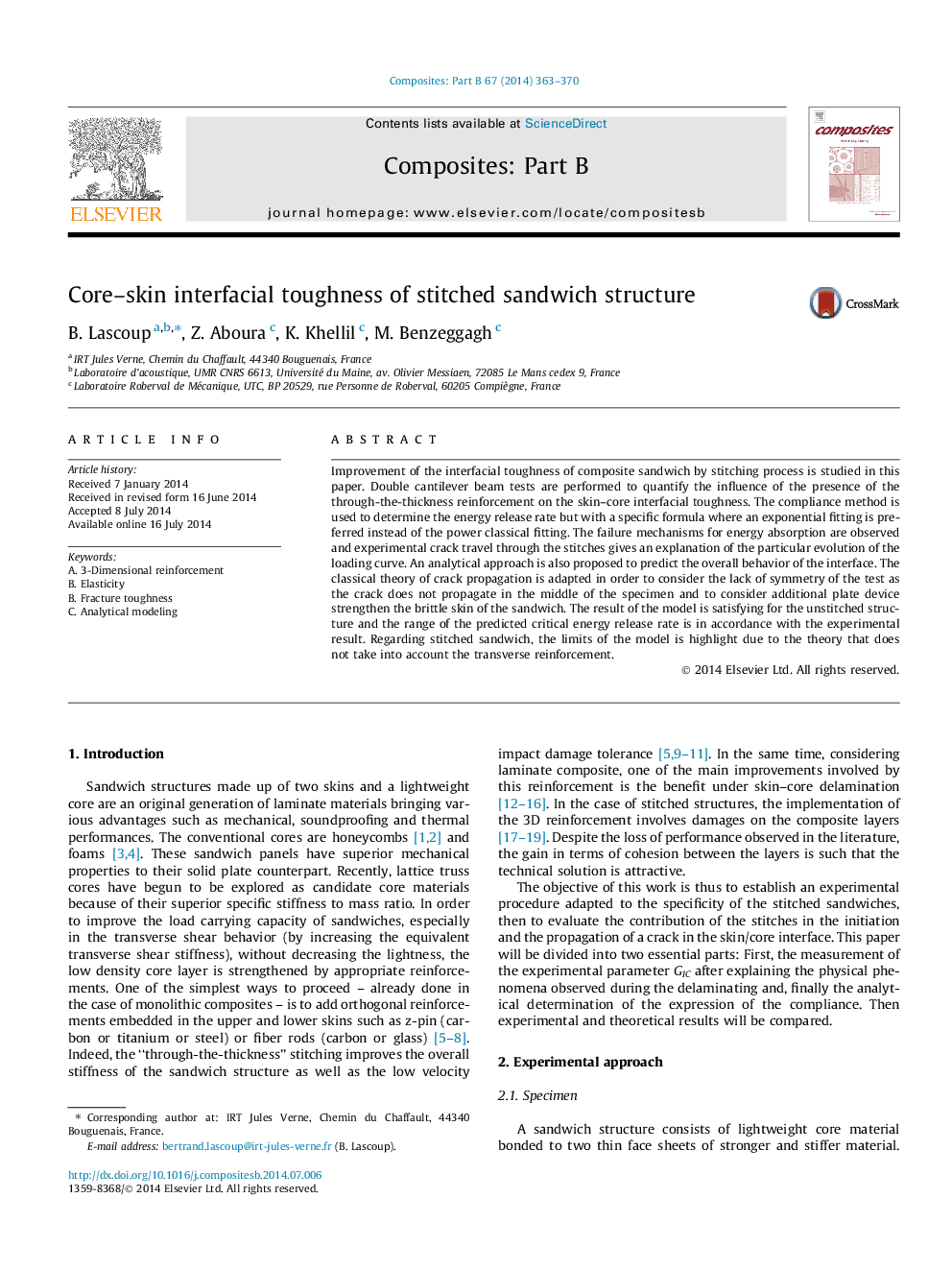| کد مقاله | کد نشریه | سال انتشار | مقاله انگلیسی | نسخه تمام متن |
|---|---|---|---|---|
| 7213426 | 1469418 | 2014 | 8 صفحه PDF | دانلود رایگان |
عنوان انگلیسی مقاله ISI
Core-skin interfacial toughness of stitched sandwich structure
ترجمه فارسی عنوان
چقرمگی ساختار ساندویچ دو طرفه هسته و پوست
دانلود مقاله + سفارش ترجمه
دانلود مقاله ISI انگلیسی
رایگان برای ایرانیان
کلمات کلیدی
ترجمه چکیده
در این مقاله، بهبود چقرمگی بین فازی ساندویچ کامپوزیتی با فرآیند دوختی مورد بررسی قرار گرفته است. آزمایشهای پرتو دو تسمه ای برای اندازه گیری تأثیر حضور تقویت شده از طریق ضخامت بر روی چقرمگی دیافراگم پوستی انجام می شود. روش انطباق برای تعیین میزان انتشار انرژی استفاده می شود، اما با یک فرمول خاص که در آن یک جسم نمایشی به جای قدرت کلاسیک قدرت ترجیح داده می شود. مکانیسم شکست برای جذب انرژی مشاهده می شود و ترک آزمایشی از طریق بخیه ها توضیح تکامل خاصی از منحنی بارگیری را می دهد. یک رویکرد تحلیلی برای پیش بینی رفتار کلی رابط نیز پیشنهاد شده است. تئوری کلاسیک انتشار تکه ای به منظور بررسی عدم تقارن تست به عنوان ترک خوردگی در وسط نمونه تطبیق می شود و در نظر گرفتن دستگاه صفحه اضافی تقویت پوست شکننده ساندویچ سازگار است. نتیجه مدل رضایتبخش است برای ساختار نامحدود و محدوده سرعت انتشار قابل توجهی که پیش بینی شده است مطابق با نتیجه آزمایش است. با توجه به ساندویچ دوخته شده، محدودیت مدل به دلیل تئوری است که تقویت عرضی را در نظر نگرفته است.
موضوعات مرتبط
مهندسی و علوم پایه
سایر رشته های مهندسی
مهندسی (عمومی)
چکیده انگلیسی
Improvement of the interfacial toughness of composite sandwich by stitching process is studied in this paper. Double cantilever beam tests are performed to quantify the influence of the presence of the through-the-thickness reinforcement on the skin-core interfacial toughness. The compliance method is used to determine the energy release rate but with a specific formula where an exponential fitting is preferred instead of the power classical fitting. The failure mechanisms for energy absorption are observed and experimental crack travel through the stitches gives an explanation of the particular evolution of the loading curve. An analytical approach is also proposed to predict the overall behavior of the interface. The classical theory of crack propagation is adapted in order to consider the lack of symmetry of the test as the crack does not propagate in the middle of the specimen and to consider additional plate device strengthen the brittle skin of the sandwich. The result of the model is satisfying for the unstitched structure and the range of the predicted critical energy release rate is in accordance with the experimental result. Regarding stitched sandwich, the limits of the model is highlight due to the theory that does not take into account the transverse reinforcement.
ناشر
Database: Elsevier - ScienceDirect (ساینس دایرکت)
Journal: Composites Part B: Engineering - Volume 67, December 2014, Pages 363-370
Journal: Composites Part B: Engineering - Volume 67, December 2014, Pages 363-370
نویسندگان
B. Lascoup, Z. Aboura, K. Khellil, M. Benzeggagh,
